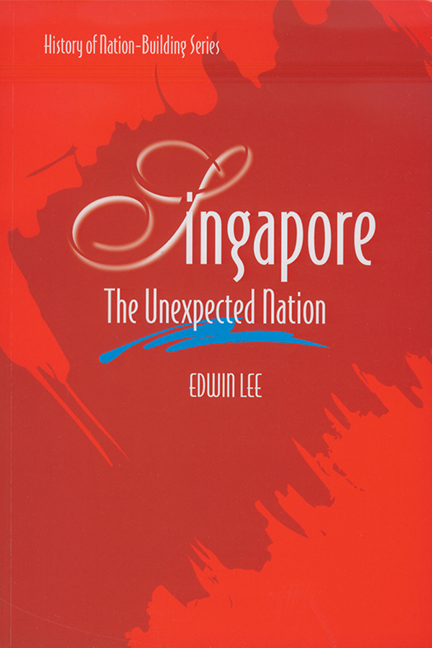Book contents
- Frontmatter
- Dedication
- Contents
- Preface
- Introduction by Wang Gungwu
- Chapter One Beginnings: From Temasek to Singapore
- Chapter Two Race, History and Nationalism
- Chapter Three Contestants and Contesting Visions
- Chapter Four The Accidental Chief Minister
- Chapter Five The Terminal Chief Minister
- Chapter Six The Embattled Prime Minister
- Chapter Seven Merger: Contesting Ownership and Principles
- Chapter Eight Terms of Disendearment
- Chapter Nine Dare to be Equal
- Chapter Ten The Way to Survive
- Chapter Eleven National Service: The Price of Independence
- Chapter Twelve Politics of Education
- Chapter Thirteen Home Ownership, National Stability and the New Middle Classes
- Chapter Fourteen University and Nation
- Chapter Fifteen Toh's Nation-Building Thrust
- Chapter Sixteen Nantah: Between Community and Nation
- Chapter Seventeen Self-Renewal: Talents for a Tough Act
- Chapter Eighteen The Consensual Prime Minister
- Chapter Nineteen Confucianism, Christianity, Chineseness
- Chapter Twenty Singapore Dreams, Singapore Dilemmas
- Chapter Twenty-One The Hyphenated Singaporean
- Chapter Twenty-Two The Unexpected Nation
- Bibliographical Note
- Index
- The Author
Chapter Two - Race, History and Nationalism
Published online by Cambridge University Press: 21 October 2015
- Frontmatter
- Dedication
- Contents
- Preface
- Introduction by Wang Gungwu
- Chapter One Beginnings: From Temasek to Singapore
- Chapter Two Race, History and Nationalism
- Chapter Three Contestants and Contesting Visions
- Chapter Four The Accidental Chief Minister
- Chapter Five The Terminal Chief Minister
- Chapter Six The Embattled Prime Minister
- Chapter Seven Merger: Contesting Ownership and Principles
- Chapter Eight Terms of Disendearment
- Chapter Nine Dare to be Equal
- Chapter Ten The Way to Survive
- Chapter Eleven National Service: The Price of Independence
- Chapter Twelve Politics of Education
- Chapter Thirteen Home Ownership, National Stability and the New Middle Classes
- Chapter Fourteen University and Nation
- Chapter Fifteen Toh's Nation-Building Thrust
- Chapter Sixteen Nantah: Between Community and Nation
- Chapter Seventeen Self-Renewal: Talents for a Tough Act
- Chapter Eighteen The Consensual Prime Minister
- Chapter Nineteen Confucianism, Christianity, Chineseness
- Chapter Twenty Singapore Dreams, Singapore Dilemmas
- Chapter Twenty-One The Hyphenated Singaporean
- Chapter Twenty-Two The Unexpected Nation
- Bibliographical Note
- Index
- The Author
Summary
Singapore's strategic location has ensured it an importance which meant that it was never alone throughout the ages of history. In the Temasek era, it was involved with rising powers in Thailand and Java, and a fading empire in Sumatra. Later, Singapore was a part of the Malay empires of Malacca and Johore. In the age of European overseas expansion, Singapore was a vital link in Britain's maritime route to China. From 1874, as Britain extended its control to the peninsular Malay states, Singapore became the capital of the expanding imperial frontier known as British Malaya, and the main port for the trade in Malayan staples, tin and rubber.
The administrative and economic ties between Singapore and Malaya were further enhanced by social and even familial ties, for both territories had a population characterized by the same ethnic diversity, though in different proportions. Singapore was the site of colleges which the British opened and later combined as the University of Malaya. Students from all over Malaya came to study in these institutions and many stayed on, giving the city state an extra layer of talent in all departments — commerce and the professions, the civil service, the judiciary, and not least, the executive branch of government, as PAP cabinet ministers. But, on the other hand, from Malaya, there also came many troublemakers and conspirators.
For all the above reasons, Singapore was often included when people referred to “Malaya” as a place or a state (generally speaking, and not specifically the “Federation of Malaya”) and to things “Malayan”. Even when, after the Second World War, Singapore was reconstituted as a Crown Colony by itself, it was still considered inseparable from Malaya, and was expected to be merged with Malaya some day. The experience of separate independent statehood was completely new for Singaporeans when it happened, abruptly, on that fateful 9 August 1965.
The ethnic variety of Singapore is greater than is suggested in the broad classification used by the PAP Government, and more or less followed here. In this book the ethnic components are, in order of size, the Chinese, the Malays (including their compatriots in the faith, the Arabs and Indian Muslims), the Indians and the Eurasians.
- Type
- Chapter
- Information
- SingaporeThe Unexpected Nation, pp. 21 - 50Publisher: ISEAS–Yusof Ishak InstitutePrint publication year: 2008

